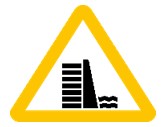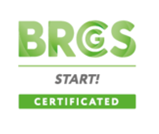Title Page
-
Site conducted
-
Conducted on
-
Prepared by
-
Location
Risk Category Standard - Product Transportation
Responsibilities
-
Who is the Risk Owner of this risk category?
-
Who is the Control Owner of the risk category?
-
Who is the Risk Executer of this risk category?
-
Who is the Task Executers of this risk category?
Competencies
-
Is the Risk Owner trained and competent to manage this risk category?
-
Is the Risk Control Owner trained and competent to manage this risk category?
-
Are the Risk Exacters trained and competent to manage this risk category?
-
Are the Task Executers trained and competent to manage this risk category?
Appointments
-
Is the Risk Owner appointed to conduct his/her duties? (Motor Fleet Officer, route planner....)
-
Is the Risk Control Owner appointed to conduct his/her duties? (Motor Fleet Officer, route planner....)
Risk Management Requirements
-
Enable and conduct the respective risk assessments for the task (IBRA, PTRA) to specify the risks and precautions to be in place for the task.
-
Maintenance is essential for all modes of road transport e.g. vehicles and trailers to ensure it is roadworthy.
-
Implement and adhere to a journey management plan, this includes a route risk assessment (RRA).
-
Refer to applicable fatigue management guidelines to ensure driver alertness while driving or when in proximity of product transportation vehicles.
-
Ensure that the driver is medically fit before driving a product transportation vehicle
-
Dangerous Goods permits and requirements are essential as per in-county legislation
-
Adhere to the Dangerous Goods transportation practices as well as the storage, packaging and handling as per in-country legislation and standards
-
Refer to the Process safety, People transportation, High-risk machinery and equipment, Working at heights risk category standards where relevant
-
The driver must be licenced, competent and alert.
-
Vehicle must be in a good condition and road worthy.
-
Conduct pre-trip inspections before transporting products.
-
Safe product handling before, during and after the journey.
-
Conduct emergency response as per risk assessment.
Licensed, Competent & Alert
-
Before the trip, the driver must ensure that a journey management plan (incl. a route risk assessment) is done and adhered to during the trip. Evaluate it continuously while traveling through high-risk areas.
-
Pre-planning of stops must be done such as rest breaks, stops for deliveries or checking of the tyres and vehicle.
-
Take regular breaks during long trips in authorised rest areas as stipulated as per in-country legislation where applicable
-
The driver must be competent, licensed and authorized to drive/operate the applicable vehicle according to the specific in-country legislation and to conduct the necessary activities as required (e.g. a Dangerous Goods Permit for SA). The driver must be trained at an approved institution as per in-country legislation
-
Always carry the Transport Emergency Card (that contains emergency and medical information) in the vehicle.
-
The driver must be trained in emergency response system and procedures and be able to implement instructions on the Transport Emergency Card
-
The driver must know the procedures to be followed in the event of stops or an incident.
-
Always ensure that the driver is familiar with all the required in-country road traffic laws and legislation for product transportation:<br>• have his/her driver’s licence with them whenever operating a vehicle.<br>• never drive any vehicle whilst under the influence of any intoxicating liquor, drugs or medication.<br>adhere to ALL the rules of the road as per in-country legislation<br>
-
Concentrate, be totally focused on the road and not be distracted by e.g. cell phones, active navigation screens, other devices, passengers
-
Continuously check all conditions and drive carefully according to current weather, road conditions and other hazards and risks.
Vehicle in good condition & road worthy
-
Statutory inspections as per local authorities is mandatory for all modes of road transport
-
Vehicle and trailer carrying dangerous goods must be registered / licensed correctly as per in-country legislation. (e.g. a Dangerous Goods Permit for SA).
-
Scheduled inspections and maintenance to be carried out on the vehicles in accordance with in-country standards. It must occur on a regular basis at fixed time intervals.
-
Make use of suitably qualified, authorised and competent persons to perform the maintenance on vehicles and trailers.
-
Ensure vehicle maintenance/service records are being kept for future reference.
-
Adhere to a documented maintenance plan for both statutory as well as preventative maintenance.
-
The parts being replaced must comply with the correct specifications.
-
Record and report all failures during the trip and repair them before the vehicle is used again.
Conduct pre-trip inspection
-
Each driver is responsible to conduct a pre-trip inspection before using the transport vehicle. It includes general checks, preliminary checks, pre-loading checks and post-loading checks.
-
The driver must be in possession of the product manifest on the vehicle, including the Transport Emergency Card and Safety Data Sheet of the product.
-
The driver must inspect and ensure all items, systems and various components are operational and in good order, before proceeding on route
-
Ensure that the statutory inspections on certain type of trailers are current and up to date, e.g. bursting disks / pressure relieve valves on tankers are in the correct position and operational
-
Ensure tankers have a valid certificate of cleanliness before loading products as per requirements
-
On any long-distance trip, the vehicle should be checked during the trip and a defect checklist completed, reported and actioned
Safe handling of product before, during & after journey.
-
Ensure that the drivers or load teams are trained on how to secure loads as well as work at heights
-
The driver must be in possession of the product manifest on the vehicle, including the Transport Emergency Card and Safety Data Sheet of the product
-
Packing must be done according to product compatibility chart (characteristic of the products). The material of packaging and the containment construction compatibility must also be suitable as per UN standards
-
Ensure proper and secure stacking and packing of product are done. Good packing practices needs to be followed
-
Ensure proper strapping of products are done, this includes but is not limited to hooks, railings, nets, straps
-
Always apply handbrake, chock blocks when the vehicle is parked for loading or offloading, and as per site requirements. Good practice is to switch off the engine and always keep the ignition keys on person
-
The vehicle must be under constant supervision during the whole journey. Be aware of opening of packages, unloading or decanting prohibitions
-
Before the loading / offloading operation, ensure the high-risk area is barricaded off.
-
Before the loading / offloading operation, ensure the overhead clearance limits and surrounding obstacles are assessed.
-
Before the loading / offloading operation, ensure the site specific inspections are carried out prior to first delivery
-
During the loading / offloading operation remain alert / aware of other moving vehicles / machinery;
-
During the loading / offloading operation be aware of the blind spots, especially for large vehicles (mining vehicles);
-
During the loading / offloading operation make sure the driver and operator are always visible to each other.
-
During the loading / offloading operation use of a spotter for reversing vehicles or where the operator does not have 360-degree view












